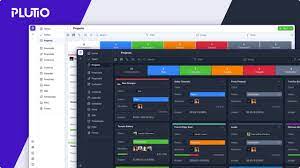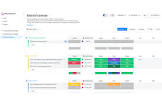Optimising Projects with a Construction Management System in the UK
Construction Management System: Streamlining Projects for Success
In the fast-paced world of construction, efficiency and organisation are key to successful project completion. This is where a Construction Management System (CMS) comes into play, offering a comprehensive solution to streamline and optimise every aspect of a construction project.
What is a Construction Management System?
A Construction Management System is a software platform designed specifically for the construction industry to help manage projects, resources, schedules, budgets, and communication effectively. It acts as a central hub where all project-related information can be accessed, updated, and monitored in real-time.
Benefits of Using a Construction Management System
- Improved Communication: CMS facilitates seamless communication between team members, subcontractors, and stakeholders through integrated messaging systems.
- Enhanced Collaboration: Teams can collaborate more efficiently by sharing documents, drawings, and progress updates in one centralised location.
- Budget Control: CMS helps track project expenses in real-time, allowing for better budget management and cost forecasting.
- Schedule Adherence: By creating detailed project schedules and task lists, CMS ensures that projects stay on track and deadlines are met.
- Risk Mitigation: Identify potential risks early on through risk management tools provided by the CMS to avoid costly delays or issues later in the project lifecycle.
Features of a Construction Management System
A typical Construction Management System may include features such as:
- Project Scheduling
- Budgeting and Cost Control
- Document Management
- Resource Allocation
- Risk Assessment and Management
- Reporting and Analytics
- Mobile Access for On-Site Updates
In Conclusion
A Construction Management System is an invaluable tool for construction companies looking to improve efficiency, reduce costs, and deliver projects on time. By leveraging the power of technology through a CMS, construction professionals can take their projects to new heights of success.
Eight Key Advantages of Implementing a Construction Management System: Streamlining Projects for Success
- Enhanced communication among team members
- Improved collaboration on project tasks
- Efficient resource allocation for optimal productivity
- Real-time tracking of project schedules and milestones
- Effective budget management and cost control
- Centralised document management for easy access to project information
- Risk mitigation through early identification and management
- Detailed reporting and analytics for informed decision-making
Assessing the Drawbacks of Construction Management Systems: Implementation Costs, Learning Curves, and Integration Hurdles
Enhanced communication among team members
Enhanced communication among team members is a significant advantage of implementing a Construction Management System (CMS) in construction projects. By providing a centralised platform for sharing information, updates, and feedback, a CMS fosters seamless collaboration and ensures that all team members are on the same page. This improved communication leads to greater efficiency, reduced misunderstandings, and ultimately results in smoother project workflows and better outcomes.
Improved collaboration on project tasks
One significant benefit of a Construction Management System is the improvement in collaboration on project tasks. By providing a centralised platform for team members, subcontractors, and stakeholders to share documents, updates, and feedback in real-time, the CMS enhances communication and coordination. This streamlined collaboration ensures that everyone involved in the project is on the same page, leading to increased efficiency, productivity, and ultimately better project outcomes.
Efficient resource allocation for optimal productivity
Efficient resource allocation is a fundamental advantage of a Construction Management System, enabling construction companies to maximise productivity and minimise waste. By utilising the advanced resource management tools offered by the CMS, project managers can assign resources effectively, track their usage in real-time, and ensure that each resource is optimally deployed throughout the project lifecycle. This streamlined approach not only enhances productivity but also helps in cost reduction and timely completion of projects, ultimately leading to greater efficiency and profitability for construction firms.
Real-time tracking of project schedules and milestones
One of the key advantages of a Construction Management System is its ability to provide real-time tracking of project schedules and milestones. By offering instant visibility into the progress of tasks and deadlines, construction teams can effectively monitor project timelines and ensure that milestones are met according to plan. This feature enables project managers to make timely adjustments, allocate resources efficiently, and address any potential delays promptly, ultimately leading to improved project efficiency and successful on-time project delivery.
Effective budget management and cost control
Effective budget management and cost control is a crucial advantage of implementing a Construction Management System (CMS) in construction projects. By utilising a CMS, project managers can track expenses in real-time, monitor budget allocations, and generate detailed cost reports. This proactive approach enables better decision-making, helps identify potential cost overruns early on, and allows for adjustments to be made to keep the project within budget constraints. Ultimately, the ability to manage costs effectively through a CMS contributes to the overall financial success of construction projects and enhances the profitability of construction companies.
Centralised document management for easy access to project information
Centralised document management is a crucial pro of a Construction Management System, providing easy access to project information for all stakeholders involved in a construction project. By storing all documents, drawings, contracts, and reports in one centralised location, team members can quickly retrieve the necessary information without the hassle of searching through multiple folders or systems. This streamlined approach not only saves time but also ensures that everyone has access to the most up-to-date project documentation, promoting collaboration and efficiency throughout the project lifecycle.
Risk mitigation through early identification and management
One significant advantage of a Construction Management System is its ability to mitigate risks through early identification and effective management. By utilising risk assessment tools and features within the system, construction professionals can proactively identify potential risks before they escalate, allowing for timely intervention and preventive measures. This proactive approach not only helps in avoiding costly delays and disruptions but also enhances overall project safety and success by addressing vulnerabilities at an early stage.
Detailed reporting and analytics for informed decision-making
One of the key benefits of a Construction Management System is its provision of detailed reporting and analytics, empowering project stakeholders with valuable insights to make informed decisions. By generating comprehensive reports on project progress, resource allocation, budget tracking, and risk assessment, construction teams can analyse data effectively to identify trends, anticipate challenges, and optimise project performance. This feature enables informed decision-making at every stage of the construction process, leading to more efficient operations and successful project outcomes.
Initial Implementation Cost
One notable drawback of adopting a Construction Management System is the substantial initial implementation cost involved. Setting up such a system often necessitates a considerable investment in acquiring the necessary software, hardware, and providing training to users. This upfront financial commitment can pose a challenge for smaller construction firms or projects with limited budgets, potentially hindering their ability to leverage the benefits of a comprehensive Construction Management System.
Learning Curve
One notable drawback of implementing a Construction Management System is the learning curve that users may encounter when adapting to a new system. This adjustment phase can lead to a temporary decrease in productivity as team members familiarise themselves with the features and functionalities of the CMS. The time and effort required to train staff on the new system may also result in initial delays or disruptions to project workflows. However, with proper training and support, users can overcome this challenge and ultimately benefit from the enhanced efficiency and organisation that a Construction Management System offers.
Integration Challenges
Integration Challenges: Integrating a Construction Management System with existing tools or workflows within a construction company can pose technical challenges and require additional time and resources. The process of aligning a new CMS with established systems can lead to disruptions in workflow, data inconsistencies, and potential compatibility issues. Moreover, training staff on the new system and ensuring seamless integration across all departments can be a complex and time-consuming endeavour. Addressing these integration challenges effectively is crucial to maximising the benefits of a Construction Management System while minimising disruptions to ongoing projects and operations within the company.




